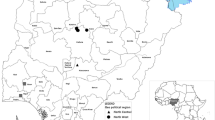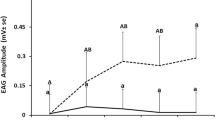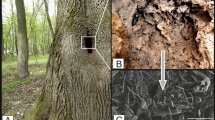Abstract
Nine compounds identified from honeybee,Apis mettifera L., sting extracts and one compound identified from the honeybee mandibular gland were evaluated in a standardized laboratory test for their effectiveness in eliciting an alarm response from caged honeybees. Two,n-decyl acetate and benzyl alcohol, were judged ineffective as alarm pheromones. The remaining eight—2-nonanol, isopentyl acetate,n-butyl acetate,n-hexyl acetate, benzyl acetate, isopentyl alcohol, andn-octyl acetate from the sting and 2-heptanone from the mandibular gland-produced responses of similar frequency and strength.
Similar content being viewed by others
References
Blum, M.S., Fales, H.M., Tucker, K.W., andCollins, A.M. 1978. Chemistry of the sting apparatus of the worker honeybee.J. Apic. Res. 17(4):218–221.
Boch, R., andRothenbuhler, W.C. 1974. Defensive behavior and production of alarm pheromone in honeybees.J. Apic. Res. 13:(4):217–221.
Boch, R., andShearer, D. A. 1971. Chemical releasers of alarm behavior in the honey-bee,Apis mettifera.J. Insect Physiol 17:2277–2285.
Boch, R., andShearer, D. A. 1966. Iso-pentyl acetate in stings of honeybees of different ages.J. Apic. Res. 5(2):65–70.
Boch, R., Shearer, D.A. andStone, B.C. 1962. Identification of isoamyl acetate as an active component in the sting pheromone of the honey bee.Nature 195:1018–1020.
Boch, R., Shearer, D.A., andPetrasovits, A. 1970. Efficacies of two alarm substances of the honey bee.J. Insect Physiol. 16:17–24.
Collins, A.M. 1979. Genetics of the response of the honeybee to an alarm chemical, isopentyl acetate.J. Apic. Res. 18(4):285–291.
Collins, A.M. 1980. Effect of age on the response to alarm pheromones by caged honey bees.Ann. Entomol. Soc. Am. 73:307–309.
Collins, A.M., andRothenbuhler, W.C. 1978. Laboratory test of the response to an alarm chemical, isopentyl acetate, byApis mellifera.Ann. Entomol. Soc. Am. 71(6):906–909.
Free, J.B., andSimpson, J. 1968. The alerting pheromones of the honeybee.Z. Vgl. Physiol. 61:361–365.
Kerr, W.E., Blum, M.S., Pisani, J.F., andShort, A.C. 1974. Correlation between amounts of 2 heptanone and iso-amyl acetate in honeybees and their aggressive behaviour.J. Apic. Res. 13(3):173–176.
Kulincevic, J.M., andRothenbuhler, W.C. 1973. Laboratory and field measurements of hoarding behavior in the honeybee.J. Apic. Res. 12(3):179–182.
Shearer, D.A., andBoch, R. 1965. 2-Heptanone in the mandibular gland secretion of the honey-bee.Nature 206:530.
Author information
Authors and Affiliations
Additional information
in cooperation with Louisiana Agricultural Experiment Station. Mention of a proprietory product does not constitute an endorsement by the USDA.
Rights and permissions
About this article
Cite this article
Collins, A.M., Blum, M.S. Bioassay of compounds derived from the honeybee sting. J Chem Ecol 8, 463–470 (1982). https://doi.org/10.1007/BF00987794
Received:
Revised:
Issue Date:
DOI: https://doi.org/10.1007/BF00987794




